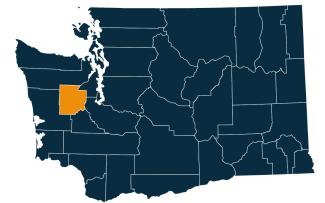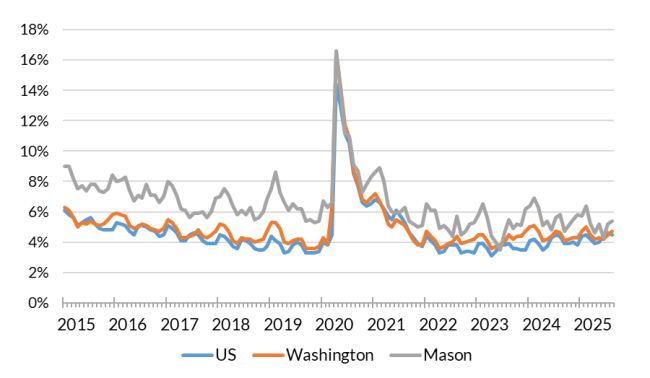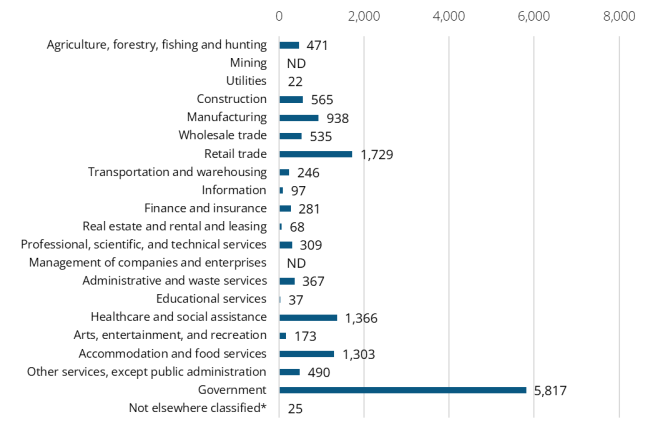Posted October 2025
August 2025 highlights
From July to August, the not seasonally adjusted unemployment rate increased from 5.2% to 5.4% and total nonfarm employment increased by 100 jobs.
Summary
Mason County is small and mostly rural. As such, the largest employment sector is local government. Many residents commute to nearby Thurston, Pierce and Kitsap Counties. Within Mason County, the largest private employment sectors are retail trade, accommodation and food services, health care and social assistance and manufacturing.
During the COVID-19 pandemic, the unemployment rate in Mason County hit a peak of 16.6%. The unemployment rate returned to pre-pandemic levels in 2022 and has remained in the range of 5% to 6% since.
Location

Mason county is in the South Puget Sound region. Its neighboring counties are Jefferson and Kitsap counties to the north, Pierce County to the east, Thurston County to the south, and Grays Harbor County to the west. The largest city is Shelton.
Mason County is part of the Pacific Mountain Workforce Development Area. Visit the Workforce Training & Education Coordinating Board website for information about the 12 workforce regions.
Employment situation for August 2025
Labor force and unemployment
-
The not seasonally adjusted unemployment rate was 5.4% in August 2025, up from 5.2% in the previous month and down from 5.8% in August 2024.
-
The total civilian labor force was 25,091 in August 2025, down from 25,305 in August 2024.
-
There were 1,349 unemployed persons in August 2025, 113 fewer than in August 2024.
Unemployment rate, not seasonally adjusted

Source: Employment Security Department/Labor Market Information and Research Division, Local area unemployment statistics
Payroll employment
-
Total nonfarm employment was 14,680 in August 2025, not seasonally adjusted. This was up by 100 jobs from the previous month, and down by 70 jobs (0.5%) from August 2024.
-
Over the course of 12 months, ending in August 2025, goods producing industries added 50 jobs (2.9%) and service providing industries lost 120 jobs (0.9%).
-
The largest increase over the year was in professional and business services, which added 50 jobs.
-
The largest decrease over the year was in other services (down 70 jobs) followed by retail trade (down 60 jobs).
Nonfarm employment estimates, not seasonally adjusted, Mason County
| NAICS Industry Title | Aug 2025 (Prelim) | Jul 2025 (Revised) | Aug 2024 (Revised) | Jul 2025 to Aug 2025 Change | Aug 2024 to Aug 2025 Change | Aug 2024 to Aug 2025 % Change |
|---|---|---|---|---|---|---|
| Total nonfarm | 14,680 | 14,580 | 14,750 | 100 | -70 | -0.5% |
| Total private (total nonfarm less government) | 8,770 | 8,720 | 8,850 | 50 | -80 | -0.9% |
| Goods-producing | 1,780 | 1,770 | 1,730 | 10 | 50 | 2.9% |
| - Mining and logging | 170 | 170 | 180 | 0 | -10 | -5.6% |
| - Construction | 600 | 600 | 580 | 0 | 20 | 3.4% |
| - Manufacturing | 1,000 | 990 | 970 | 10 | 30 | 3.1% |
| Service-providing | 12,900 | 12,810 | 13,020 | 90 | -120 | -0.9% |
| - Wholesale trade | 390 | 360 | 380 | 30 | 10 | 2.6% |
| - Retail trade | 1,590 | 1,580 | 1,650 | 10 | -60 | -3.6% |
| - Transportation, warehousing, and utilities | 270 | 280 | 300 | -10 | -30 | -10.0% |
| - Information | 100 | 100 | 100 | 0 | 0 | 0.0% |
| - Financial activities | 360 | 360 | 390 | 0 | -30 | -7.7% |
| - Professional and business services | 750 | 730 | 700 | 20 | 50 | 7.1% |
| - Private education and health services | 1,430 | 1,420 | 1,440 | 10 | -10 | -0.7% |
| - Leisure and hospitality | 1,620 | 1,620 | 1,590 | 0 | 30 | 1.9% |
| - Other services | 500 | 500 | 570 | 0 | -70 | -12.3% |
| - Government | 5,900 | 5,860 | 5,900 | 40 | 0 | 0.0% |
Note: Data benchmarked through March 2025, updated September 15, 2025.
Source: Employment Security Department/Labor Market Information and Research Division, Washington employment estimates (WA-QB & CES)
Detailed tables can be found on the source page in the third spreadsheet titled Current employment estimates, not seasonally adjusted.
Industry employment (covered employment)
Employment by industry, Mason County 2024 annual average

Source: Employment Security Department/Labor Market Information and Research Division, Covered Employment (QCEW)
Average annual covered employment in Mason County was 14,840 in 2024. This was up from 14,639 in 2023. Covered employment refers to workers who received wages in Washington state and are eligible for state and federal unemployment insurance (UI) compensation programs.
Government is the largest employer in Mason County. At 5,817 jobs, this sector is as large as the next three biggest (retail trade, health care and social assistance and accommodation and food services).
Top five sectors in terms of employment in 2024:
-
Government (5,817)
-
Retail trade (1,729)
-
Health care and social assistance (1,366)
-
Accommodation and food services (1,303)
-
Manufacturing (938)
The average annual wage in Mason County was $57,899 in 2024. This was up from $54,836 in 2023, a 5.6% increase. Except for government, the industries with the highest wages in the county tend to be small.
Top five sectors in terms of wages in 2024:
-
Mining and management of companies and enterprises ($151,764)
-
Professional, scientific and technical services ($90,325)
-
Finance and insurance ($78,052)
-
Information ($75,697)
-
Government ($73,276)
Workforce demographics for Mason County
Mason County has a large population 55 and older, which contributes to a lower labor force participation rate (50.5%) than the statewide average. Younger workers tend to have higher unemployment, as do workers with disabilities (11.4% unemployment) and those with less than a high school diploma (11.0% unemployment). Visit the U.S. Census Bureau website for quick facts about Mason County.
Age
| Demographic characteristic | Total | Labor force participation rate | Unemployment rate |
|---|---|---|---|
| Population 16 years and over | 55,467 | 50.5% | 6.6% |
| 16 to 19 years | 2,885 | 33.8% | 21.8% |
| 20 to 24 years | 3,251 | 76.1% | 16.7% |
| 25 to 29 years | 3,891 | 75.5% | 8.1% |
| 30 to 34 years | 4,117 | 70.1% | 4.1% |
| 35 to 44 years | 7,914 | 74.6% | 7.3% |
| 45 to 54 years | 7,268 | 73.6% | 5.9% |
| 55 to 59 years | 4,642 | 69.2% | 2.4% |
| 60 to 64 years | 5,617 | 45.0% | 0.5% |
| 65 to 74 years | 9,982 | 16.0% | 2.0% |
| 75 years and over | 5,900 | 3.1% | 4.4% |
Race or Hispanic origin
| Demographic characteristic | Total | Labor force participation rate | Unemployment rate |
|---|---|---|---|
| White alone | 45,183 | 48.5% | 4.9% |
| Black or African American alone | 637 | 54.0% | 9.6% |
| American Indian and Alaska Native alone | 1,008 | 41.6% | 6.0% |
| Asian alone | 634 | 59.5% | 9.5% |
| Native Hawaiian and other Pacific Islander alone | 176 | 49.4% | 3.4% |
| Some other race alone | 2,818 | 66.6% | 16.8% |
| Two or more races | 5,011 | 60.0% | 12.2% |
| Hispanic or Latino origin (of any race) | 5,049 | 66.0% | 13.1% |
| White alone, not Hispanic or Latino | 44,088 | 48.4% | 4.9% |
| Population 20 to 64 years | 36,700 | 68.9% | 6.3% |
Sex
| Demographic characteristic | Total | Labor force participation rate | Unemployment rate |
|---|---|---|---|
| Male | 19,587 | 72.7% | 6.4% |
| Female | 17,113 | 64.5% | 6.3% |
Females with children
| Demographic characteristic | Total | Labor force participation rate | Unemployment rate |
|---|---|---|---|
| With own children under 18 | 5,030 | 68.5% | 8.3% |
| With own children under 6 only | 1,263 | 70.6% | 3.5% |
| With own children under 6 and 6 to 17 | 1,090 | 58.0% | 4.6% |
| With own children 6 to 17 only | 2,677 | 71.8% | 11.7% |
Poverty status in the past 12 months
| Demographic characteristic | Total | Labor force participation rate | Unemployment rate |
|---|---|---|---|
| Below poverty level | 4,549 | 38.2% | 22.7% |
| At or above the poverty level | 31,136 | 75.6% | 5.1% |
Disability status
| Demographic characteristic | Total | Labor force participation rate | Unemployment rate |
|---|---|---|---|
| With any disability | 6,164 | 39.0% | 11.4% |
Educational attainment
| Demographic characteristic | Total | Labor force participation rate | Unemployment rate |
|---|---|---|---|
| Population 25 to 64 years | 33,449 | 68.2% | 5.2% |
| Less than high school graduate | 3,660 | 58.5% | 11.0% |
| High school graduate (includes equivalency) | 10,282 | 63.7% | 7.7% |
| Some college or associate's degree | 12,685 | 69.1% | 3.1% |
| Bachelor's degree or higher | 6,822 | 78.4% | 3.4% |
Source: U.S. Census Bureau, American Community Survey 5-year estimates, S2301 | Employment Status.
This workforce product was funded by a grant awarded by the U.S. Department of Labor's Employment and Training Administration. The product was created by the recipient and does not necessarily reflect the official position of the U.S. Department of Labor. The Department of Labor makes no guarantees, warranties, or assurances of any kind, expressed or implied, with respect to such information, including any information on linked sites and including, but not limited to, accuracy of the information or its completeness, timeliness, usefulness, adequacy, continued availability, or ownership. This product is copyrighted by the institution that created it. Internal use by an organization and/or personal use by an individual for non-commercial purposes is permissible. All other uses require the prior authorization of the copyright owner.


